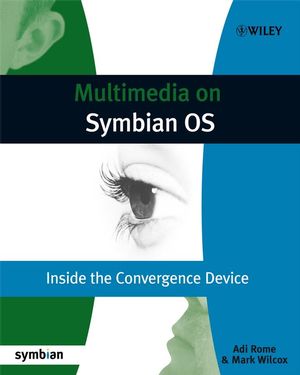Multimedia on Symbian OS: Inside the Convergence DeviceISBN: 978-0-470-69507-4
Paperback
276 pages
November 2008
 This title is out-of-print and not currently available for purchase from this site.
|
About this Book.
Authors’ Biographies.
Authors’ Acknowledgements.
Symbian Press Acknowledgments.
Code Conventions and Notations.
1 Introduction.
1.1 The Convergence Device.
1.2 Transformation of the Media Industry.
1.3 Symbian OS.
1.4 The Cutting Edge.
1.5 Evolution of the Multimedia Subsystem in Symbian OS.
1.6 A Peek into the Future.
2 Multimedia Architecture.
2.1 The ECOM Framework.
2.2 Platform Security.
2.3 The Content Access Framework.
2.4 Multimedia Subsystem.
2.5 Future Multimedia Support.
3 The Onboard Camera.
3.1 Introduction.
3.2 Accessing the Camera.
3.3 Camera Control.
3.4 Displaying the Viewfinder.
3.5 Capturing Still Images.
3.6 Capturing Video.
3.7 Error Handling.
3.8 Advanced Topics.
4 Multimedia Framework: Video.
4.1 Video Concepts.
4.2 Symbian OS Video Architecture.
4.3 Client API Introduction.
4.4 Identifying Video Controllers.
4.5 Controlling Video Playback.
4.6 Controlling Screen Output.
4.7 Getting Video Information.
4.8 Accessing Metadata.
4.9 Controlling the Audio Output.
4.10 Streaming Playback.
4.11 Recording Video.
4.12 Controlling the Video that Is Recorded.
4.13 Controlling the Audio that Is Recorded.
4.14 Storing Metadata.
4.15 Custom Commands.
4.16 Examples and Troubleshooting.
5 Multimedia Framework: Audio.
5.1 Introduction.
5.2 Audio Input and Output Streams.
5.3 Audio Player Utility.
5.4 Audio Recorder Utility.
5.5 File Conversion.
5.6 Tone Utility.
5.7 DevSound.
5.8 Audio Policies.
5.9 Priority Settings.
5.10 Miscellaneous.
6 Image Conversion Library.
6.1 Introduction.
6.2 Decoding Images.
6.3 Encoding Images.
6.4 Displaying Images.
6.5 Transforming Images.
6.6 Native Bitmap Operations.
6.7 Miscellaneous APIs.
7 The Tuner API.
7.1 Introduction.
7.2 Getting Started.
7.3 Basic Use Cases.
7.4 Future Technologies.
7.5 Sample Code.
8 Best Practice.
8.1 Always Use an Active Scheduler.
8.2 Use APPARC to Recognize Audio and Video.
8.3 Don’t Use the Video Player to Open Audio Files.
8.4 Know that MMF and ICL Cannot Detect Some Formats.
8.5 Don’t Use CMdaAudioOutputStream for Network Streaming.
8.6 Use CMdaAudioPlayerUtility to Play Tone Sequence Files.
8.7 Use CMdaAudioPlayerUtility to Play Clips.
8.8 Don’t Hardwire Controller UIDs in Portable Code.
8.9 Set Controller Thread Priorities Before Playing or Recording.
8.10 Recognize that Behavior Varies when Several Clients Are Active.
8.11 Understand that the System is Based on Plug-ins.
8.12 Use RFile and TMMSource Instead of Passing a File Name.
8.13 Consider the Volume Control.
8.14 Know When to Use Threaded Requests on ICL.
8.15 Don’t Have too many Clients.
8.16 Understand the Multi-heap Problem.
References and Resources.
Index.



